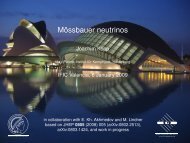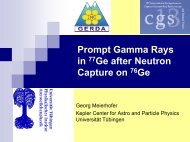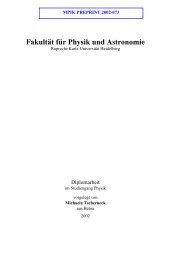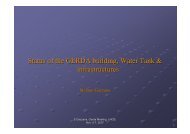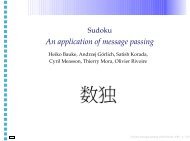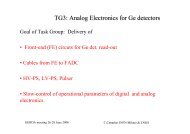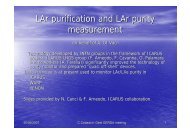Master Thesis
Master Thesis
Master Thesis
Create successful ePaper yourself
Turn your PDF publications into a flip-book with our unique Google optimized e-Paper software.
One can see, that the differentials build a vector space too, which is named cotangent space or dual space. In<br />
particular, the component functions x i : M 4 →�, x i(x 1, x 2, x 3, x 4)= x i satisfy<br />
(d xi)(∂ j)=∂ j x i =〈d x i ,∂ j〉=δ i<br />
j , (3.7)<br />
which is the reason, why the d x i are said to be the basis of the dual base T∗ p (M). The corresponding ‘vector’ in the dual<br />
spaceω=ω id x i∈ T∗ p (M) is called a one-form.<br />
Definition 3.2.3 (Vector Field). Let p∈ M be a point of a manifold M. The mapping X : p→X p is called a vector field<br />
on M. The set of all smooth (C ∞ ) vector fields on M is denoted by�(M). The set of all smooth mappingsω : p→ω p of<br />
one-forms on M is denoted by� ∗ (M)<br />
In local coordinates(x 1, x 2, x 3, x 4) of an open subset U∈M,�(M) and� ∗ (M) have the representations:<br />
3.3 Tensors andtheir transformationbehavior<br />
X p=ξ i �<br />
∂<br />
(p)<br />
∂ x i<br />
�<br />
∈�(M) ωp=ζ i(p)<br />
p<br />
� d x i�<br />
p ∈�∗ (M) (3.8)<br />
i ∂<br />
Let X= X<br />
∂ x i∈�(M) be a vector andω=ω id x i∈� ∗ (M) a one-form. Under the change of coordinates given by the<br />
mapping x ′ : M 4→ N 4 , x ′i (x 1 , x2 , x3 , x4 ), x ′ (p)= q the vectors transform in the following way:<br />
X .x i′<br />
k′ ∂ j i′<br />
= X x = X<br />
j∂ x<br />
j ∂ x ∂ x jδi′<br />
ω( ∂ ∂<br />
∂ x i′)= ∂ x i′ω jd x j =ω j<br />
∂ x j<br />
∂ x<br />
k′δ k′<br />
i<br />
k′ i′ x<br />
k ′=∂ X<br />
j∂x<br />
j ∂ x ∂ x k′ = X<br />
j<br />
∂ x<br />
′=<br />
∂ x k′ω ∂ x<br />
j<br />
k′<br />
∂ x i′ = ∂<br />
∂ x i′ω k ′d x k′<br />
k′ ∂<br />
∂ x k′ x i′<br />
(3.9)<br />
(3.10)<br />
By comparing the coefficients one comes to the conclusion, that the components of the vectors and one-forms transform<br />
with the Jacobian of the coordinate change, also named tangent map<br />
X i′<br />
= ∂ x i′<br />
j<br />
X<br />
∂ x j<br />
,<br />
∂ i′<br />
X= X<br />
∂ x i′∈�(N)<br />
(3.11)<br />
j ∂ x<br />
ωi ′=<br />
∂ x i′ω j , ω=ω i ′d x i′<br />
∈� ∗ (N) . (3.12)<br />
The tensorial product of r vectors Y a= Y i a ∂ia ∈�(M) and s one-formsΩ b =Ω jb d x j b ∈� ∗ (M) leads to an object:<br />
T = Y 1⊗ . . .⊗ Y r⊗Ω 1 ⊗ . . .⊗Ω s = (3.13)<br />
= T i1...ir j ∂i1⊗ . . .⊗∂ ir⊗ d x<br />
1...j s j1 js ⊗ . . .⊗ d x (3.14)<br />
T i1...ir j1...j s<br />
= Y i 1 · . . .· Y i r·Ωj1 · . . .·Ω js , (3.15)<br />
which is transformed component-wise by the tangential mapping of the coordinate change:<br />
T i′<br />
1 ...i′ r<br />
j ′<br />
1 ...j′ =<br />
s<br />
∂ x i′<br />
1<br />
∂ x k · . . .·<br />
1<br />
∂ x i′<br />
r<br />
∂ x k r<br />
· ∂ x l1 ∂ x j′<br />
· . . .·<br />
1<br />
∂ x ls ∂ x j′ · T<br />
s<br />
k1...kr l1...ls (3.16)<br />
As a result of this transformation properties, T∈� r<br />
s (M) is called a tensor field of type (r,s) (contra-variant of rank r,<br />
covariant of rank s).<br />
The numbers T i1...ir j need not be a product of components of vectors, as it is done in equation (3.15). The∂ i1⊗ . . .⊗<br />
1...j s<br />
∂ ir ⊗ d x j 1⊗ . . .⊗ d x j s are then the dim(� r<br />
s (M))=nr+s basis elements of the cartesian product� r<br />
s (M)= T pM× . . .× T pM×<br />
T ∗<br />
p<br />
M× . . .× T∗<br />
p<br />
M of the tensor space.<br />
Given a linear transformation Ai′ r<br />
j , tensors T∈� s (M) transform in general by:<br />
A(T) : T i′<br />
1 ...i′<br />
r<br />
j ′<br />
1 ...j′ s<br />
= A i′<br />
1<br />
k 1<br />
· . . .·A i′<br />
r<br />
k r<br />
· A l1 j ′ · . . .·A<br />
1<br />
ls j ′ · T<br />
s<br />
k1...kr l1...ls (3.17)<br />
10 3.3 Tensors andtheirtransformation behavior



